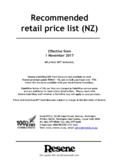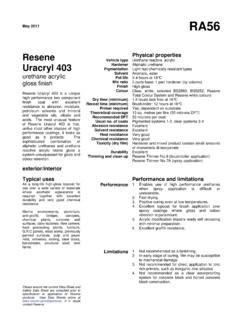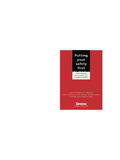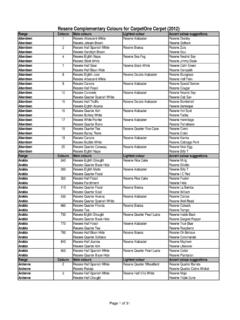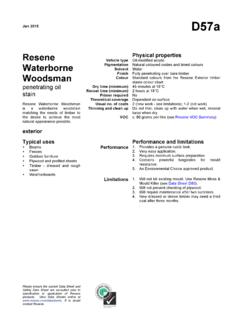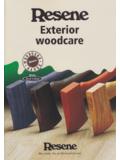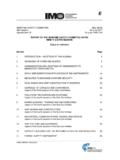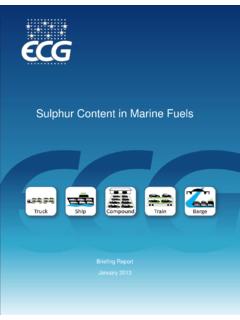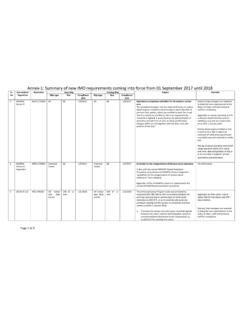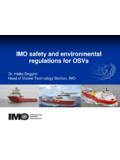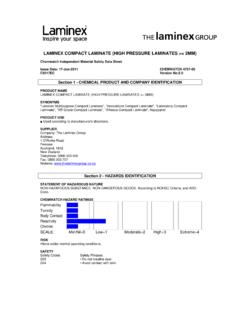Transcription of RESENE BOILED LINSEED OIL
1 Damar Industries LimitedChemwatch Hazard Alert Code: 1 ANDREW BOILED LINSEED OILV ersion No: Data Sheet according to HSNO RegulationsIssue Date: 30/11/2015 Print Date: 29/04 1 IDENTIFICATION OF THE SUBSTANCE / MIXTURE AND OF THE COMPANY / UNDERTAKINGP roduct IdentifierProduct nameANDREW BOILED LINSEED OILC hemical Namelinseed oilSynonymsALT0135, ALP0135, ALE0135, ALK0135, ALG0135, ALL0135, ALR0135 Other means of identificationALX0135, ALE0135, ALG0135, ALK0135, ALL0135, ALP0135, ALR0135, ALT0135 CAS number8001-26-1*Relevant identified uses of the substance or mixture and uses advised againstRelevant identified usesGenerally used to treat and protect treated timbers flooring, furniture, wooden of the supplier of the safety data sheetRegistered company nameDamar Industries LimitedAddress800 Te Ngae Road, Eastgate Business Park, Rotorua 3042 New ZealandTelephone073456007 Fax+64 7 345 telephone numberAssociation / OrganisationDamar Industries LtdEmergency telephonenumbers0800 243 622 Other emergency telephonenumbers1800 127 406 (outside New Zealand)
2 SECTION 2 HAZARDS IDENTIFICATIONC lassification of the substance or mixtureNot considered a Hazardous Substance according to the criteria of the New Zealand Hazardous Substances New Organisms regulated for transport of Dangerous HAZARD RATINGSMaxMinFlammability1 Toxicity0 Body Contact0 Reactivity1 Chronic00 = Minimum1 = Low2 = Moderate3 = High4 = ExtremeClassificationNot ApplicableDetermined by Chemwatchusing GHS/HSNO criteriaNot AvailableLabel elementsHazard pictogram(s)Not ApplicableSIGNAL WORDNOT APPLICABLEH azard statement(s)Not ApplicablePrecautionary statement(s) PreventionNot ApplicablePrecautionary statement(s) ResponseNot ApplicablePage 1 statement(s) StorageNot ApplicablePrecautionary statement(s) DisposalNot ApplicableSECTION 3 COMPOSITION / INFORMATION ON INGREDIENTSS ubstancesCAS No%[weight]Name8001-26-1>99 Not Available< section above for composition of SubstancesSECTION 4 FIRST AID MEASURESD escription of first aid measuresEye ContactIf this product comes in contact with eyes: Wash out immediately with water.
3 If irritation continues, seek medical attention. Removal of contact lenses after an eye injury should only be undertaken by skilled personnel. Skin ContactIf skin or hair contact occurs:Flush skin and hair with running water (and soap if available). Seek medical attention in event of irritation. For thermal burns:Decontaminate area around the use of cold packs and topical first-degree burns (affecting top layer of skin)Hold burned skin under cool (not cold) running water or immerse in cool water until pain compresses if running water is not with sterile non-adhesive bandage or clean NOT apply butter or ointments; this may cause over-the counter pain relievers if pain increases or swelling, redness, fever second-degree burns (affecting top two layers of skin)Cool the burn by immerse in cold running water for 10-15 compresses if running water is not NOT apply ice as this may lower body temperature and cause further NOT break blisters or apply butter or ointments.
4 This may cause burn by cover loosely with sterile, nonstick bandage and secure in place with gauze or prevent shock: (unless the person has a head, neck, or leg injury, or it would cause discomfort):Lay the person feet about 12 burn area above heart level, if the person with coat or medical third-degree burnsSeek immediate medical or emergency the mean time:Protect burn area cover loosely with sterile, nonstick bandage or, for large areas, a sheet or other material that will not leave lint in burned toes and fingers with dry, sterile not soak burn in water or apply ointments or butter; this may cause prevent shock see an airway burn, do not place pillow under the person's head when the person is lying down. This can close the a person with a facial burn sit pulse and breathing to monitor for shock until emergency help arrives. InhalationIf fumes, aerosols or combustion products are inhaled remove from contaminated area. Other measures are usually unnecessary.
5 IngestionImmediately give a glass of water. First aid is not generally required. If in doubt, contact a Poisons Information Centre or a doctor. Indication of any immediate medical attention and special treatment neededTreat 5 FIREFIGHTING MEASURESE xtinguishing mediaFoam. Dry chemical powder. BCF (where regulations permit). Carbon dioxide. Water spray or fog - Large fires only. Special hazards arising from the substrate or mixtureFire IncompatibilityAvoid contamination with oxidising agents nitrates, oxidising acids, chlorine bleaches, pool chlorine etc. as ignition may result LINSEED oilManganese drierVersion No: 2 of 16 ANDREW BOILED LINSEED OILI ssue Date: 30/11/2015 Print Date: 29/04 for firefightersFire FightingAlert Fire Brigade and tell them location and nature of hazard. Wear full body protective clothing with breathing apparatus. Prevent, by any means available, spillage from entering drains or water course. Use water delivered as a fine spray to control fire and cool adjacent area.
6 Avoid spraying water onto liquid pools. DO NOT approach containers suspected to be hot. Cool fire exposed containers with water spray from a protected location. If safe to do so, remove containers from path of fire. Fire/Explosion HazardCombustible. Slight fire hazard when exposed to heat or flame. Heating may cause expansion or decomposition leading to violent rupture of containers. On combustion, may emit toxic fumes of carbon monoxide (CO). May emit acrid smoke. Mists containing combustible materials may be explosive. Combustion products include:,carbon dioxide (CO2),acrolein ,other pyrolysis products typical of burning organic emit poisonous : Water in contact with hot liquid may cause foaming and a steam explosion with wide scattering of hot oil and possible severe may cause overflow of containers and may result in possible 6 ACCIDENTAL RELEASE MEASURESP ersonal precautions, protective equipment and emergency proceduresSee section 8 Environmental precautionsSee section 12 Methods and material for containment and cleaning upMinor SpillsSlippery when all ignition sources.
7 Clean up all spills immediately. Avoid breathing vapours and contact with skin and eyes. Control personal contact with the substance, by using protective equipment. Contain and absorb spill with sand, earth, inert material or vermiculite. Wipe up. Place in a suitable, labelled container for waste disposal. Major SpillsSlippery when : Absorbent materials wetted with occluded oil must be moistened with water as they may auto-oxidize, become self heating and oils slowly oxidise when spread in a film and oil on cloths, mops, absorbents may autoxidise and generate heat, smoulder, ignite and the workplace oily rags should be collected and immersed in hazard. Clear area of personnel and move upwind. Alert Fire Brigade and tell them location and nature of hazard. Wear breathing apparatus plus protective gloves. Prevent, by any means available, spillage from entering drains or water course. No smoking, naked lights or ignition sources. Increase ventilation.
8 Stop leak if safe to do so. Contain spill with sand, earth or vermiculite. Collect recoverable product into labelled containers for recycling. Absorb remaining product with sand, earth or vermiculite. Collect solid residues and seal in labelled drums for disposal. Wash area and prevent runoff into drains. If contamination of drains or waterways occurs, advise emergency services. Personal Protective Equipment advice is contained in Section 8 of the 7 HANDLING AND STORAGEP recautions for safe handlingSafe handlingRags wet / soaked with unsaturated hydrocarbons / drying oils may auto-oxidise; generate heat and, in-time, smoulder and ignite. This isespecially the case where oil-soaked materials are folded, bunched, compressed, or piled together - this allows the heat to accumulate or evenaccelerate the reactionOily cleaning rags should be collected regularly and immersed in water, or spread to dry in safe-place away from direct sunlight or stored,immersed, in solvents in suitably closed all personal contact, including inhalation.
9 Wear protective clothing when risk of exposure occurs. Use in a well-ventilated area. Prevent concentration in hollows and sumps. DO NOT enter confined spaces until atmosphere has been checked. DO NOT allow material to contact humans, exposed food or food utensils. Avoid contact with incompatible materials. Version No: 3 of 16 ANDREW BOILED LINSEED OILI ssue Date: 30/11/2015 Print Date: 29/04 handling, DO NOT eat, drink or smoke. Keep containers securely sealed when not in use. Avoid physical damage to containers. Always wash hands with soap and water after handling. Work clothes should be laundered separately. Launder contaminated clothing before re-use. Use good occupational work practice. Observe manufacturer's storage and handling recommendations contained within this should be regularly checked against established exposure standards to ensure safe working conditions are maintained. Other informationStore in original containers. Keep containers securely sealed.
10 No smoking, naked lights or ignition sources. Store in a cool, dry, well-ventilated area. Store away from incompatible materials and foodstuff containers. Protect containers against physical damage and check regularly for leaks. Observe manufacturer's storage and handling recommendations contained within this SDS. Conditions for safe storage, including any incompatibilitiesSuitable containerGlass container is suitable for laboratory quantities DO NOT use aluminium or galvanised containersMetal can or drum Packaging as recommended by manufacturer. Check all containers are clearly labelled and free from leaks. Storage incompatibilityContact with high pressure oxygen may cause ignition / :Although anti-oxidants may be present, in the original formulation, these may deplete over time as they come into contact with air. Rags wet / soaked with unsaturated hydrocarbons / drying oils may auto-oxidise; generate heat and, in-time, smoulder and ignite. This isespecially the case where oil-soaked materials are folded, bunched, compressed, or piled together - this allows the heat to accumulate oreven accelerate the reaction Oily cleaning rags should be collected regularly and immersed in water, or spread to dry in safe-place away from direct stored,immersed, in solvents in suitably closed containers.
